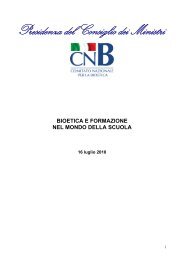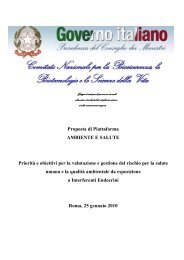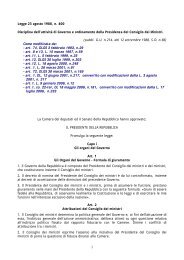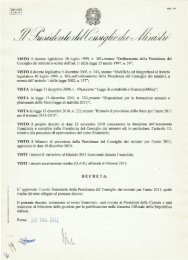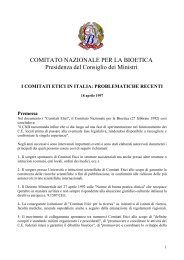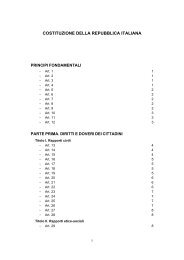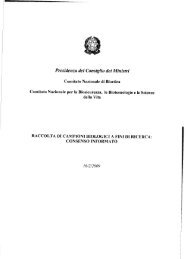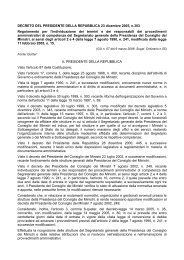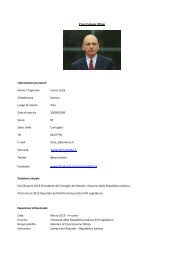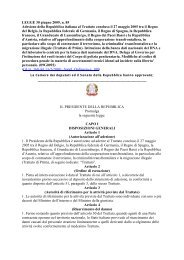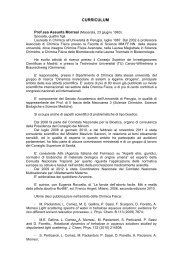President
President
President
You also want an ePaper? Increase the reach of your titles
YUMPU automatically turns print PDFs into web optimized ePapers that Google loves.
warm ischemia, and this happens (in this phase, which can be considered in<br />
many ways still experimental) with the use of increasingly more accurate<br />
investigations to ascertain death. It is about determining the time period<br />
considered sufficient for the duration of resuscitation attempts and for the tests<br />
indentifying the permanent interruption of the cardiac function to certify that<br />
anoxia has in effect caused the irreversible destruction of the whole<br />
encephalus 228 .<br />
The central ethical question, therefore, concerns respecting the “dead<br />
donor rule” (similarly to what happens with regards to ascertaining death with<br />
neurological criteria), according to which organs can be removed only after the<br />
patient’s death. Consequently, it is essential to determine the criteria that allow<br />
ascertaining death, the way it is expected when ascertaining death with<br />
neurological criteria, in terms of equivalent diagnostic certainty 229 .<br />
In literature and in international protocols we find a consensus about the<br />
diagnostic criteria for cardiac arrest, but there is no consensus in determining<br />
which observation time periods for the cessation of circulation and respiration<br />
are necessary but also prudent in order to declare the cardiac death<br />
irreversible. We find a variable time, which fluctuates between 2 and 20<br />
minutes. The time is decided on the basis of more or less prudent empirical<br />
experiences, namely, on the basis of the observation that, after a certain<br />
amount of time from the cardiac arrest and after interrupting all attempts at<br />
assisting with medical instruments, the heart does not start beating again and it<br />
is not able to start beating again, believing that the cessation of circulation<br />
implies an irreversible whole brain damage.<br />
It must also be said that determining an observation time that guarantees<br />
ascertaining the death of the individual, is in effect strongly linked in many<br />
countries to the different categories of donors, to which they refer for the<br />
removal of organs.<br />
The Maastricht protocol (1995) 230 identifies 4 categories: I- patients who<br />
have had the cardiac arrest outside the hospital and whose death is declared<br />
when arriving at A&E; II- patients who die in hospital after ineffective<br />
resuscitation 231 ; III- dying patients, especially those in intensive care units,<br />
whose care is interrupted after a certain fatal prognosis 232 ; IV- patients whose<br />
228 The “cardio-pulmonary” criterion is also linked to the neurological criterion of ascertaining<br />
death, on the basis of the organismic reality of the so-called Bishat tripod, which unavoidably<br />
links, in the case of the lack of (substitutive) human intervention, the loss of one of the three<br />
functions: respiratory, cardiac, neurological, to the subsequent loss of the others, independently<br />
from the order with which the first of the functions has suffered the catastrophic damage of the<br />
organism’s external or internal noxa.<br />
229 Valko, Ethical implications of non-heart-beating organ donation, “Medicine and Morality”,<br />
Michaelmas 2002, vol. XVII, n. 3; J.B. Shea, Non-heart-beating organ donation, 1 September<br />
2003, www.lifeissues.net.<br />
230 G. Koostra, J.H. Daemen, A.P. Oomen, Categories of non-heart-beating donors, “Transplant<br />
Prod.”, 1995, 27, 5, pp. 2893-2894. The Maastricht protocol, which identified the categories of<br />
non-heart-beating donors, came from the first international Workshop on these issues. The<br />
protocol has quickly become a point of reference in European and international literature from a<br />
practical perspective, in order to group different categories for healthcare purposes and to<br />
verify the outcomes of transplants in different clinical conditions, in which the policy of acquiring<br />
transplant organs from individuals who died from cardiac arrest is trialled. Therefore, it is<br />
possible to compare statistics, which are necessarily still limited (survival after the transplant,<br />
rate of rejection or lack of functioning of the transplanted kidney, etc.).<br />
231 This represents the majority of the pool of non-heart-beating donors in Europe.<br />
232 This represents the majority of non-heart-beating donors in the USA. It is a category of<br />
patients that in Italy cannot be considered legitimate according to the laws in force: the law<br />
174




